Cichlids are some of the most popular freshwater aquarium fish due to their inquisitive nature and interesting habits.
These species really like to explore their environment and appreciate rockwork and caves in their tank. Rock decorations look great and give the fish a feeling of security.

Rock rough surfaces also provide the perfect home for beneficial bacteria that biologically purify the water.
There are many rock and stone materials to choose from, but it’s important to select the right type of rock for your cichlid species.
In this article
Water Chemistry and Cichlids
Some rocks, like Texas Holey Rock, contain limestone and will slowly increase water hardness and pH. This is fine for African cichlid aquariums.
However, if you’re keeping South American cichlids that like soft, acid water, this type of rock will make it impossible to stabilize the water chemistry.
If you’re new to cichlids I recommend researching the type of water your fish prefer.
There are cichlids from African rift lakes, like Lake Tanganyika and Lake Malawi, that prefer hard water. South American cichlids tend to like soft water.
Some species are relatively hardy and will live in most types of water.
Other cichlids have very specific water chemistry needs that must be met for the fish to thrive.
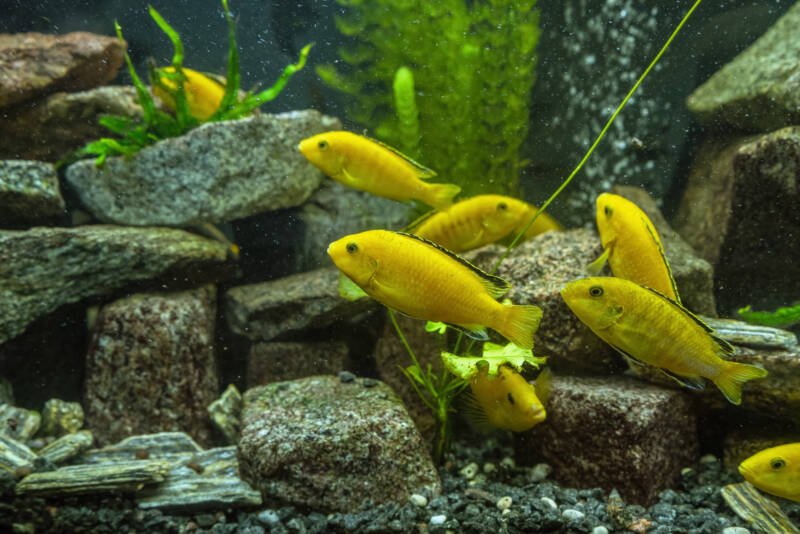
Here is a list of common cichlids and the type of water they inhabit.
Hard water with a pH above 7.5
- Peacock cichlids
- Mbuna
- Zebra cichlid
- Brichardi
Medium hardness with a pH of 7.0-8.0
Low hardness and a pH of 6.0-7.0
Types of Rocks for Cichlid Aquariums

There are three types of rock for aquascaping your tank.
Mined rock is dug from the ground and broken into various sizes for aquarium use.
Stones are also “rock” in that they contain minerals but are often processed to have smooth edges.
Synthetic resin is molded into rock-like shapes. Resin rocks are lighter than natural rock and sometimes snap together to form caves, ledges, and cliffs.
Can live rock be used in a cichlid aquarium?

“Live rock” is a term for natural or artificial rocks used in reef tanks.
Most live rock used to build a reef tank is full of calcium carbonate.
It will increase pH level and water hardness. Some African cichlid enthusiasts use “dry rock” in their tanks.
Dry rock is calcium-rich rock without the coral and other marine life that normally coats the rock. This makes it safe to use in an African cichlid tank.
Aquascaping with Rocks
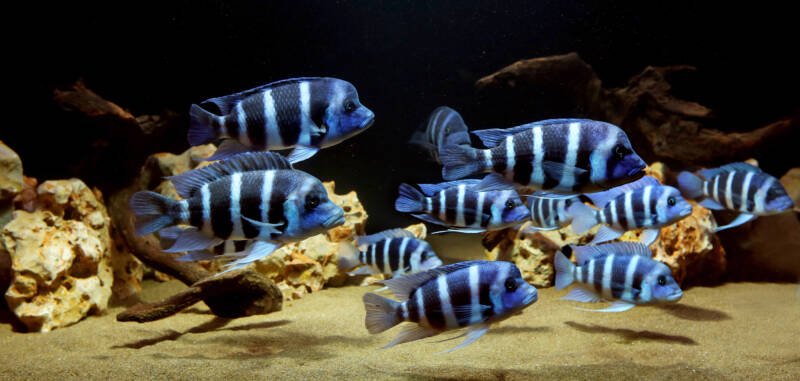
While there are no specific rules for aquascaping with rocks, there are a few helpful tips to consider.
- Some cichlids like to have their own cave. It’s a secure hiding place and may even turn into a spawning area. When building a cave, make it a little larger than the fish that will live in it. You can construct multiple caves and see which one your fish likes best. Sometimes the fish will swim in and out of all of them.
- African cichlids can become quite territorial. If there are too few caves for all the fish, they may start fighting over territory. It’s best to build more caves than fish. Another option is to simply aquascape with rocks and stones, being careful to create no tempting caves. This will all but eliminate territorial fighting over cave space.
- If you find a certain cichlid becomes overly protective of a certain territory and begins chasing all the other fish away, change the rock layout a little and see if it stops the aggression.
Be careful with sand and gravel

Cichlids love to move the substrate. If they find a rock or crevice they like, they’ll often start excavating about the base.
If they dig too much, it may cause the rock pile to collapse.
For this reason, many cichlid-keepers place the first layer of rock directly on the bottom of the aquarium.
This stabilizes the rocks, even if fish dig around the substrate.
Live rock and African cichlids
You may know live rock from the reef-keeping hobby. The calcium-based rock eventually becomes covered with corals and other marine life.
You can purchase “dry rock”, which is calcium-based reef rock that has been dried and cleaned of dead marine life.
Some African cichlid enthusiasts have aquascaped with live rock because it helps to make the water hard.
What kinds of rock are safe for cichlid aquariums?
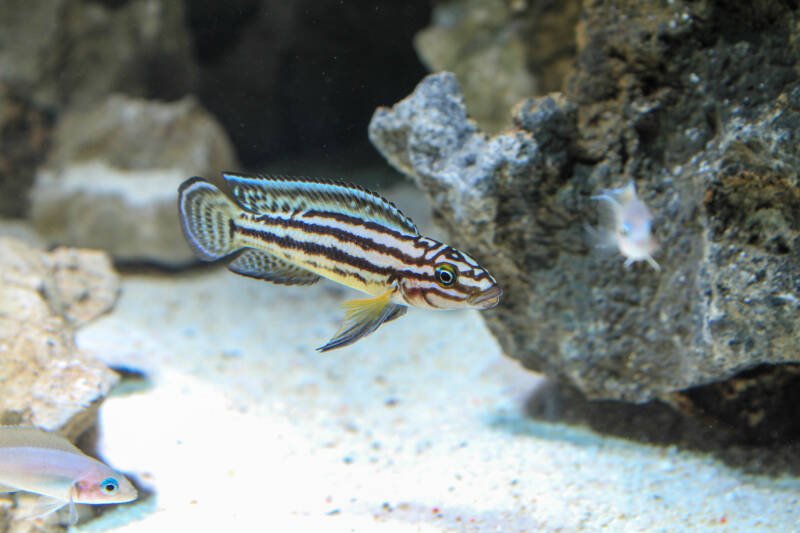
While there are many types of aquarium-safe rocks and stones, it’s important to know if the rock will increase water hardness and pH.
If you’re aquascaping an African cichlid tank, you can use just about any rock, not just calcium-rich types.
If you’re trying to keep an Amazonian aquarium, you would not use rock that releases calcium carbonate into the water.
When shopping for aquarium rock, be sure you understand how it will affect water chemistry. Our in-depth look at aquarium rocks can be found here.
What about sharp rocks?
Many aquarium fish will scratch on the gravel or rock. The reason could be a simple “itch” on their skin, or they are responding to a tiny parasite.
Cichlids will occasionally scratch against a rock. As long as there isn’t a parasite outbreak, there’s nothing to worry about.
But what about rocks with a rough surface, like lava rock?
Some aquarists worry their fish will rub themselves raw on rough rock. While it is possible it is very rare.
Lava and other rough rock have been used in aquariums for decades. Fish won’t accidentally scratch their skin and cause a wound.
The greater danger comes when trying to chase down a cichlid with a net.
The frightened fish very well may dart into a rock pile while trying to escape. In this case, it’s better to remove the rocks first, then net the fish.
Preparing Rocks for the Aquarium
Natural rock and stone can be completely safe for the aquarium but still require some preparation for the tank.
Some rocks are softer than others and carry rock dust inside their pores. It helps to rinse off the rock under running water to flush out loose particles.
If you gather rocks from nature, I suggest soaking them in a bucket of water overnight. Then scrub off soil and other debris that you don’t want in your tank.
My Favorite Rocks for Cichlid Aquariums
There are many types of rock to choose from, but I have four favorites:
- Slate: flat, easy to create caves, can be placed upright to create “mountains” and alleys.
- Mountain stone: Looks like a mountain and is a great accent rock
- Texas holey rock: Lots of holes for small African cichlids, increases hardness and pH
- Resin-based rock: Lightweight and easy for the beginner to use.
1. Slate Rock

Slate can be found in black, red, and gray colors.
Sometimes it has a mottled “rusty” appearance from iron deposits.
The flat slabs can be used to quickly build a cave. The flat surface makes it easy to balance on other rocks.
It is easy to break large pieces into smaller sections with a gentle tap of a hammer.
Slate won’t change water chemistry and it is a favorite spawning site for egg-laying fish.
2. Mountain Stone
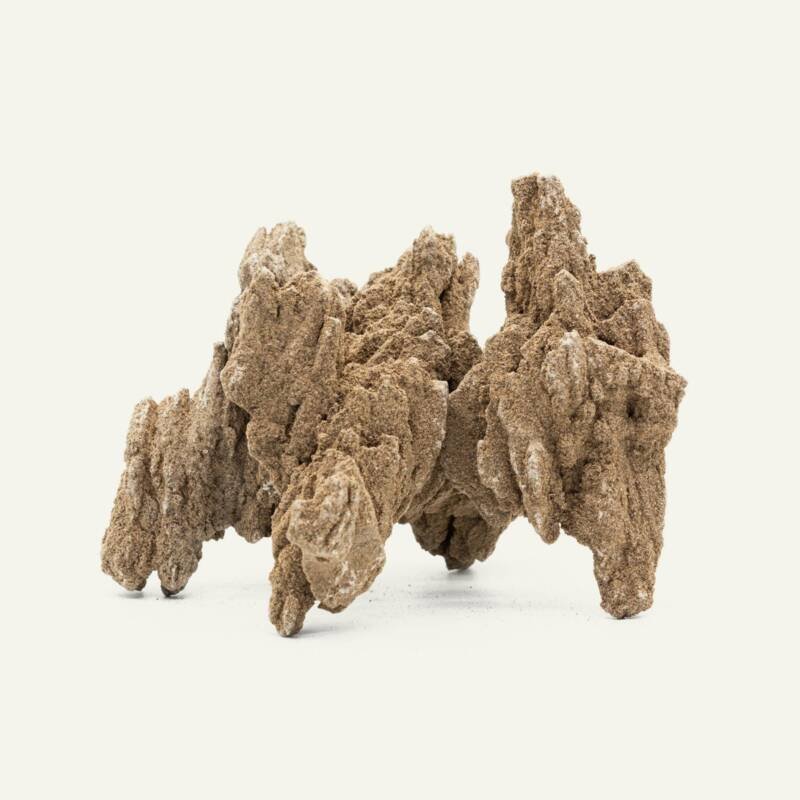
This type of rock looks like a weathered mountain.
You can lay it flat on the gravel, but I like to use it as an upright pillar.
Its shape and sand-like texture give the aquascape depth and interest. You can use this rock with any cichlid.
It is very lightweight and easy to position in the aquarium.
3. Texas Holey Rock
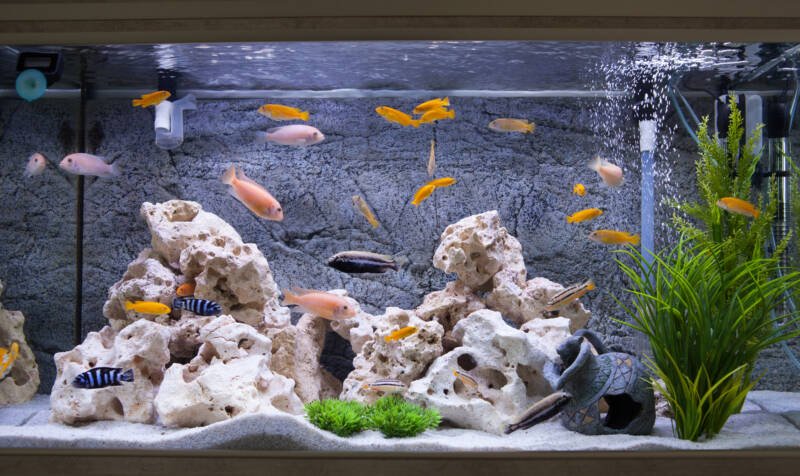
This is a favorite with African cichlid fans. Small fish will swim through the holes.
It provides a hiding place if you have a mix of large and small cichlids.
This rock releases calcium raises hardness, and will increase pH slightly.
4. Artificial Resin Rocks
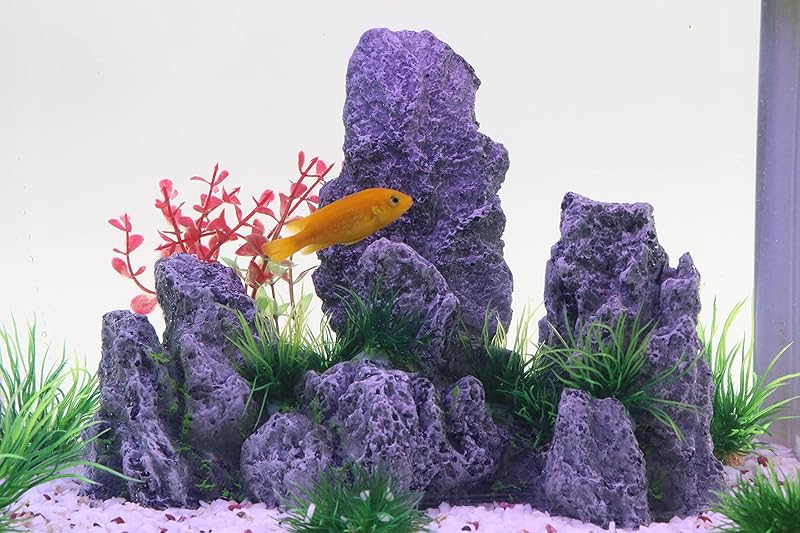
Not everyone has access to real rock and stone. Plastic rock kits are available anywhere.
They’re lighter than real rock and available in multiple sizes.
Many resin rocks are manufactured to lock into place, creating natural-looking caves.
Closing Thoughts
If you keep African cichlids you’ve probably noticed how they love to dig. They’ll move gravel or rock around until they find their “perfect spot”. The more caves and hiding spots you provide, the happier your fish will be.
When choosing rock begin with an aquascaping plan for your tank. Is it an Amazon freshwater or African cichlid? This will help narrow down the choices. Then you need to consider if the rock will change water chemistry. Finally, look at how easy it is to work with.
If you have questions or comments, please leave them below.